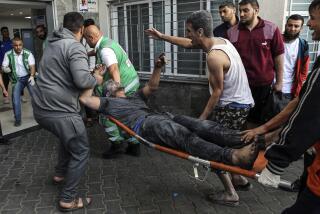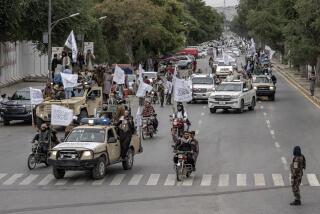Still a land of danger
- Share via
The helicopter crash in Afghanistan that killed eight Navy SEALs last month was the worst single-day death toll in the proud unit’s history. Last week’s London subway and bus bombings were yet another display of coordinated Al Qaeda-style slaughter.
One was an act of war and the other of terror, yet both are grim reminders that Al Qaeda and its spreading affiliates flourish and Osama bin Laden remains at large.
Not much had been heard of the Al Qaeda founder recently until President Bush quoted him in his Fort Bragg, N.C., pep talk two weeks ago, by coincidence the same day the helicopter crashed, killing the SEALs and the eight-member Army crew. Bush mentioned a Bin Laden statement that the “Third World War” was raging in Iraq; the president did not trot out his oft-repeated post-9/11 pledge to capture Bin Laden dead or alive.
In the months after 9/11, U.S. troops quickly ousted Afghanistan’s Taliban rulers, depriving Al Qaeda of its protectors, but the terrorists largely melted into the mountain wilds and across the border into Pakistan, even as warlords long suppressed by the Taliban began to rise back to regional power.
About 18,000 U.S. troops and 8,000 more from other nations remain in the country, hunting foes and trying to protect the nation-building being attempted by a weak government and its main ally, the U.S. But the rocket-propelled grenade attack on the copter was the latest in a spate of violent incidents demonstrating that Afghanistan remains insecure.
A roadside bomb killed four U.S. soldiers in June outside Kandahar, the city where weeks earlier a suicide bomber killed more than 20 Afghan civilians gathered at a mosque for a Muslim cleric’s funeral. Nearly 60 U.S. servicemen have been killed in Afghanistan this year, the most since the invasion. There’s no chance of adding substantially to U.S. troops when 140,000 are stationed in Iraq, a war that continues to divert U.S. attention and resources.
In the absence of more troops, Afghan President Hamid Karzai needs other help from U.S. and foreign aid groups to make progress outside Kabul. Villagers complain of roads still unbuilt and warlords who hold sway in the absence of Afghan security forces. If Karzai was allowed to personally direct aid funds where they would do the most good, he would look less like Washington’s puppet. Unfortunately, the corruption of officials under him makes that a hard choice.
Karzai’s election in October and the earlier writing of a constitution represented progress in the recovery from decades of war. Legislative elections in September could mark another advance but will not if Afghans continue to see Karzai’s government as a do-nothing regime.
Bush promised Karzai at a White House meeting in May to continue U.S. military and economic aid. Status quo is not enough in the country that spawned the 9/11 attacks. Iraq may be the new global center for urban terrorism, as judged in recent CIA reports. That hasn’t subtracted from Afghanistan’s dangers, as the sophistication of the recent violence too graphically shows.
More to Read
Sign up for Essential California
The most important California stories and recommendations in your inbox every morning.
You may occasionally receive promotional content from the Los Angeles Times.













